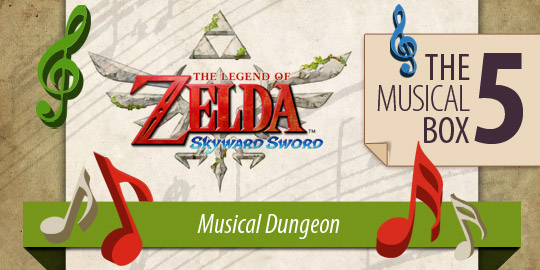The Musical Box #05: Musical dungeon
The Musical Box features 30 articles focusing on game music production and implementation. Edition #5: The Legend of Zelda: Skyward Sword


The Legend of Zelda: Skyward Sword was one of the biggest Nintendo releases in 2011. The game was very well received by the gaming community, and featured controls that felt like a “real” sword.
Since the Zelda series is known for its beautiful music, I am going to explore (once again) the musical implementation of one particular song in Skyward Sword: the theme for the first "dungeon" of the game, Skyview Temple.
The Set-Up
Link and Zelda live in a floating city called Skyloft. After the Wing Ceremony, during which Link is to become a knight, Zelda disappears and our hero must rescue her, and perhaps save the world in the process.
Creating music for RPG/Adventure games is a big challenge. Since players spend a long time exploring, the music has to provide a suitable background that doesn't become boring even when the player doesn't know how to proceed.
This is especially important in dungeons in Zelda. In these locations, players can spend a lot of time trying to solve puzzles. It is not uncommon to spend more than an hour in such places. So, how is it possible to create music that repeats for a full hour without becoming annoying?
Nintendo's solution is simple and clever, as you can see below.
The Moment
The musical theme for Skyview Temple is short and has a fairly simple instrumentation and structure.
To make this short loop more pleasant, Nintendo developers implemented different mixes for the same music, thus changing the instrumentation according to the room the player is currently in. When exploring a large room, the music is played with the main melody. In smaller rooms, this melody is not played. For the player, it sounds like a slightly different version of the same music and this helps mitigate the undesirable effects of musical repetition.
When Link reaches a bigger room in this same dungeon, the player hears a fuller version of the harmony for this theme. This is a very straightforward approach that is tied to the level design: the bigger the room, the fuller the musical arrangement.
The Impact
Nintendo's solution for Skyward Sword is elegant and budget friendly. From a compositional point of view, there is just one single theme for the whole dungeon experience. However, because it is presented in different ways, it never becomes too boring, even if you spend many hours listening to it.
I should point out that this is not entirely an innovation. They used a similar technique in Zelda: The Spirits Tracks. Nevertheless, it remains a very clever solution that can be used in many situations and different games.
What about you? Did you notice that particular moment? Are there other memorable moments in Skyward Sword you would like to share? Feel free to comment below, in English or Portuguese!
Special thanks: Gilliard Lopes, Rafael Kuhnen, Fernando Secco, Sandro Tomasetti, and Rafael Martins (Sommastudio).
About the Author
You May Also Like









